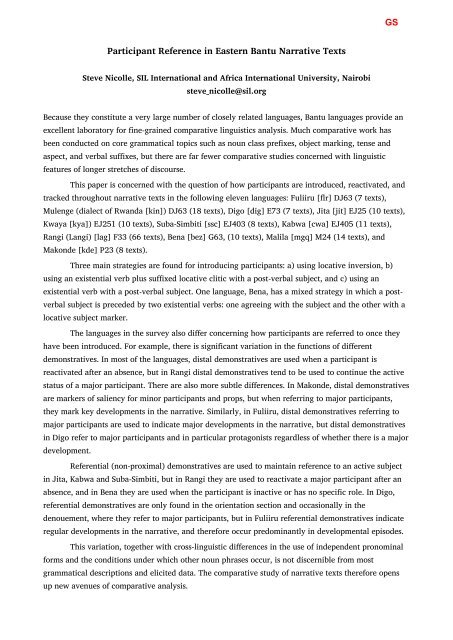here - 5th International Conference on Bantu Languages
here - 5th International Conference on Bantu Languages
here - 5th International Conference on Bantu Languages
You also want an ePaper? Increase the reach of your titles
YUMPU automatically turns print PDFs into web optimized ePapers that Google loves.
Participant Reference in Eastern <strong>Bantu</strong> Narrative Texts<br />
Steve Nicolle, SIL <str<strong>on</strong>g>Internati<strong>on</strong>al</str<strong>on</strong>g> and Africa <str<strong>on</strong>g>Internati<strong>on</strong>al</str<strong>on</strong>g> University, Nairobi<br />
steve_nicolle@sil.org<br />
Because they c<strong>on</strong>stitute a very large number of closely related languages, <strong>Bantu</strong> languages provide an<br />
excellent laboratory for fine-grained comparative linguistics analysis. Much comparative work has<br />
been c<strong>on</strong>ducted <strong>on</strong> core grammatical topics such as noun class prefixes, object marking, tense and<br />
aspect, and verbal suffixes, but t<str<strong>on</strong>g>here</str<strong>on</strong>g> are far fewer comparative studies c<strong>on</strong>cerned with linguistic<br />
features of l<strong>on</strong>ger stretches of discourse.<br />
This paper is c<strong>on</strong>cerned with the questi<strong>on</strong> of how participants are introduced, reactivated, and<br />
tracked throughout narrative texts in the following eleven languages: Fuliiru [flr] DJ63 (7 texts),<br />
Mulenge (dialect of Rwanda [kin]) DJ63 (18 texts), Digo [dig] E73 (7 texts), Jita [jit] EJ25 (10 texts),<br />
Kwaya [kya]) EJ251 (10 texts), Suba-Simbiti [ssc] EJ403 (8 texts), Kabwa [cwa] EJ405 (11 texts),<br />
Rangi (Langi) [lag] F33 (66 texts), Bena [bez] G63, (10 texts), Malila [mgq] M24 (14 texts), and<br />
Mak<strong>on</strong>de [kde] P23 (8 texts).<br />
Three main strategies are found for introducing participants: a) using locative inversi<strong>on</strong>, b)<br />
using an existential verb plus suffixed locative clitic with a post-verbal subject, and c) using an<br />
existential verb with a post-verbal subject. One language, Bena, has a mixed strategy in which a post-<br />
verbal subject is preceded by two existential verbs: <strong>on</strong>e agreeing with the subject and the other with a<br />
locative subject marker.<br />
The languages in the survey also differ c<strong>on</strong>cerning how participants are referred to <strong>on</strong>ce they<br />
have been introduced. For example, t<str<strong>on</strong>g>here</str<strong>on</strong>g> is significant variati<strong>on</strong> in the functi<strong>on</strong>s of different<br />
dem<strong>on</strong>stratives. In most of the languages, distal dem<strong>on</strong>stratives are used when a participant is<br />
reactivated after an absence, but in Rangi distal dem<strong>on</strong>stratives tend to be used to c<strong>on</strong>tinue the active<br />
status of a major participant. T<str<strong>on</strong>g>here</str<strong>on</strong>g> are also more subtle differences. In Mak<strong>on</strong>de, distal dem<strong>on</strong>stratives<br />
are markers of saliency for minor participants and props, but when referring to major participants,<br />
they mark key developments in the narrative. Similarly, in Fuliiru, distal dem<strong>on</strong>stratives referring to<br />
major participants are used to indicate major developments in the narrative, but distal dem<strong>on</strong>stratives<br />
in Digo refer to major participants and in particular protag<strong>on</strong>ists regardless of whether t<str<strong>on</strong>g>here</str<strong>on</strong>g> is a major<br />
development.<br />
Referential (n<strong>on</strong>-proximal) dem<strong>on</strong>stratives are used to maintain reference to an active subject<br />
in Jita, Kabwa and Suba-Simbiti, but in Rangi they are used to reactivate a major participant after an<br />
absence, and in Bena they are used when the participant is inactive or has no specific role. In Digo,<br />
referential dem<strong>on</strong>stratives are <strong>on</strong>ly found in the orientati<strong>on</strong> secti<strong>on</strong> and occasi<strong>on</strong>ally in the<br />
denouement, w<str<strong>on</strong>g>here</str<strong>on</strong>g> they refer to major participants, but in Fuliiru referential dem<strong>on</strong>stratives indicate<br />
regular developments in the narrative, and t<str<strong>on</strong>g>here</str<strong>on</strong>g>fore occur predominantly in developmental episodes.<br />
This variati<strong>on</strong>, together with cross-linguistic differences in the use of independent pr<strong>on</strong>ominal<br />
forms and the c<strong>on</strong>diti<strong>on</strong>s under which other noun phrases occur, is not discernible from most<br />
grammatical descripti<strong>on</strong>s and elicited data. The comparative study of narrative texts t<str<strong>on</strong>g>here</str<strong>on</strong>g>fore opens<br />
up new avenues of comparative analysis.<br />
GS


